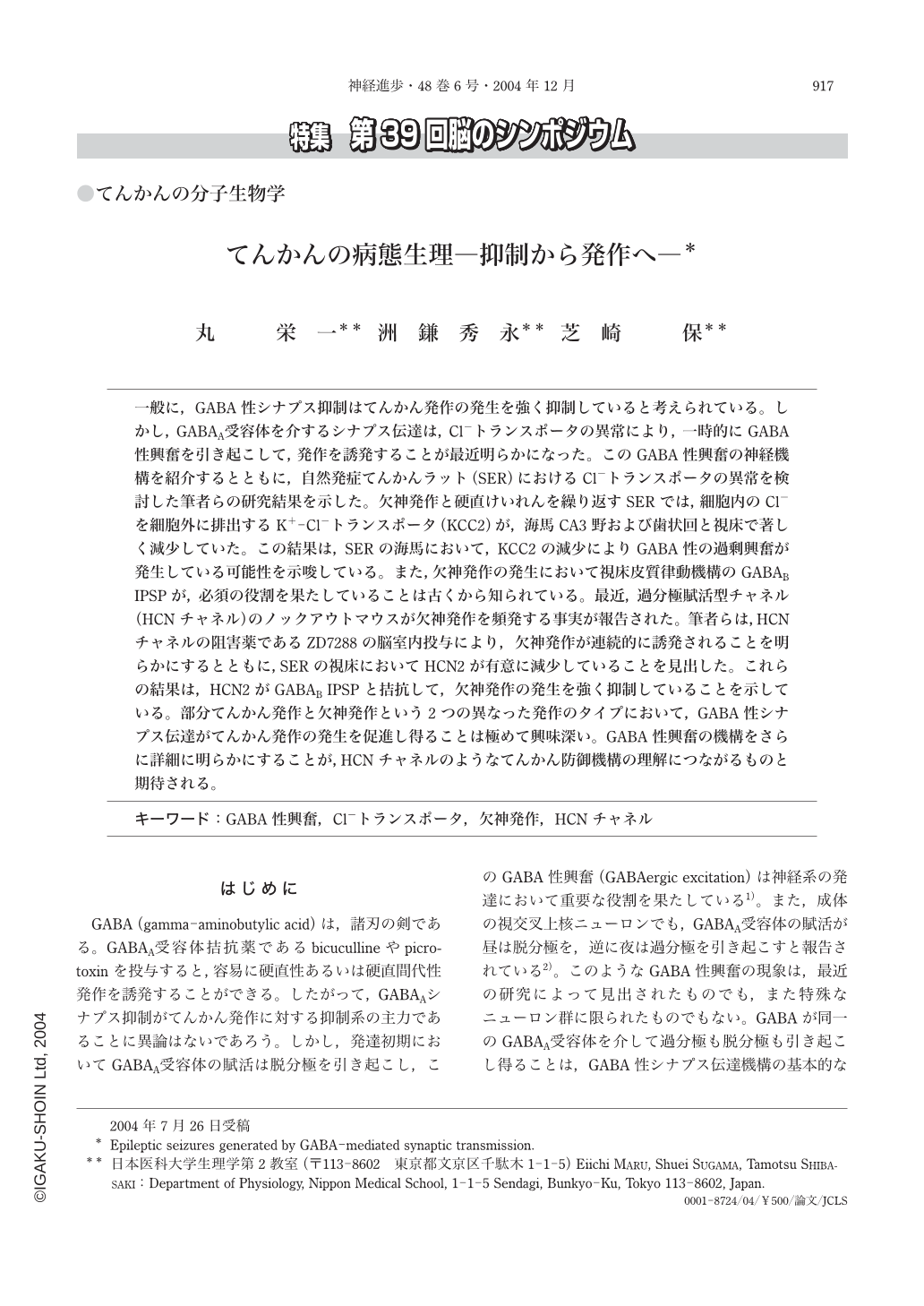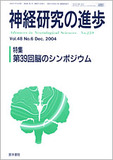Japanese
English
- 有料閲覧
- Abstract 文献概要
- 1ページ目 Look Inside
一般に,GABA性シナプス抑制はてんかん発作の発生を強く抑制していると考えられている。しかし,GABAA受容体を介するシナプス伝達は,Cl-トランスポータの異常により,一時的にGABA性興奮を引き起こして,発作を誘発することが最近明らかになった。このGABA性興奮の神経機構を紹介するとともに,自然発症てんかんラット(SER)におけるCl-トランスポータの異常を検討した筆者らの研究結果を示した。欠神発作と硬直けいれんを繰り返すSERでは,細胞内のCl-を細胞外に排出するK+-Cl-トランスポータ(KCC2)が,海馬CA3野および歯状回と視床で著しく減少していた。この結果は,SERの海馬において,KCC2の減少によりGABA性の過剰興奮が発生している可能性を示唆している。また,欠神発作の発生において視床皮質律動機構のGABAB IPSPが,必須の役割を果たしていることは古くから知られている。最近,過分極賦活型チャネル(HCNチャネル)のノックアウトマウスが欠神発作を頻発する事実が報告された。筆者らは,HCNチャネルの阻害薬であるZD7288の脳室内投与により,欠神発作が連続的に誘発されることを明らかにするとともに,SERの視床においてHCN2が有意に減少していることを見出した。これらの結果は,HCN2がGABAB IPSPと拮抗して,欠神発作の発生を強く抑制していることを示している。部分てんかん発作と欠神発作という2つの異なった発作のタイプにおいて,GABA性シナプス伝達がてんかん発作の発生を促進し得ることは極めて興味深い。GABA性興奮の機構をさらに詳細に明らかにすることが,HCNチャネルのようなてんかん防御機構の理解につながるものと期待される。
Although GABA-mediated synaptic transmission inhibits the generation of epileptic seizures strongly during an interictal period, recent studies indicate that GABA-mediated transmission elicits the depolarizing, but not hyperpolarizing, response in postsynaptic neurons and generates epileptic seizures. GABAA receptor-mediated responses shift from hyperpolarizing to depolarizing as a consequence of an increase in the intracellular Cl- concentration that is predominantly regulated by Cl- transporters. The down-regulation of the Cl- -extruding K+/Cl- co-transporter(e. g. KCC2)and/or the up-regulation of the Na+/K+-2Cl- co-transporter(e. g. NKCC1)are considered to result in GABAA receptor-mediated hyperexcitation following an increase in the intracellular Cl- concentration. It has recently been demonstrated that the expression of KCC2mRNA and protein were down-regulated in the whole hippocampal formation and BDNF/TrkB signaling decreased the expression of KCC2 following hippocampal kinding. In addition, amygdala kindling was shown to up-regulated the NKCC1mRNA in hippocampal dentate area and piriform cortex, with KCC2mRNA unchanged. Furthermore, KCC2gene knockout mice showed increased susceptibility for epileptic seizures. In a preliminary study we observed that KCC2 immunoreactivity significantly decreased in the hippocampal CA3 area of the spontaneously epileptic rat(SER)as compared with control rats. These data suggest that abnormalities of the neuronal Cl- transporters may induce GABAA receptor-mediated hyperexcitation presumably by reducing KCC2 through BDNF/TrkB signaling pathways, and play a critical role in the generation of the partial epileptic seizures.
GABA-mediated synaptic transmission also facilitates the generation of a different type of epileptic, seizure, namely the absence epilepsy. Absence epilepsy is characterized by a sudden behavioral arrest and a transient interruption of consciousness accompanied by a characteristic EEG pattern of 3Hz spike and wave discharge(SWD). SWD is well-known to stem from the inherent thalamocortical oscillatory mechanism that usually induces the sleep spindle wave in the cortex. In the thalamocortical oscillatory mechanism, GABAergic neurons in the nucleus reticularis thalami evoke a long-lasting inhibitory postsynaptic potential(IPSP)via GABAB receptor activation as well as GABAA IPSP in thalamocortical relay neurons(TC neurons). The long-lasting GABAB IPSP effectively removes the inactivation of low-threshold Ca2+ channel(T-type Ca2+ channel)and elicits periodically low-threshold Ca2+ potentials that in tern give rise to bursts of Na+ action potentials. It was reported that a GABAB receptor agonist, baclofen, markedly generated absence seizures and that a GABAB receptor antagonist, CGP35348, attenuated or blocked the pentylenetetrazol-induced absence seizures.
It was demonstrated that the periodicity of thalamic spindle waves was abolished and continuous 6-10Hz oscillations were generated by ZD7288, a blocker of the hyperpolarization-activated and cyclic nucleotide-gated cation channels(HCN channels)which was discovered as a cardiac pacemaker channel. Furthermore, spontaneous absence seizures were frequently observed in mice lacking the pacemaker channel HCN2. We examined the effects of ZD7288 on EEG and behavior in freely moving rats. An intracerebroventricular administration of ZD7288(500μM, 4μL)induced frequently behavioral arrests associated with 1-5.5Hz rhythmic waves like absence seizures. We also found that HCN2 immunoreactivity significantly decreased in the thalamic areas of SER compared with control rats. These findings indicate that the activation of HCN channels prevents the generation of absence seizures against the long-lasting GABAB hyperpolarization.

Copyright © 2004, Igaku-Shoin Ltd. All rights reserved.


